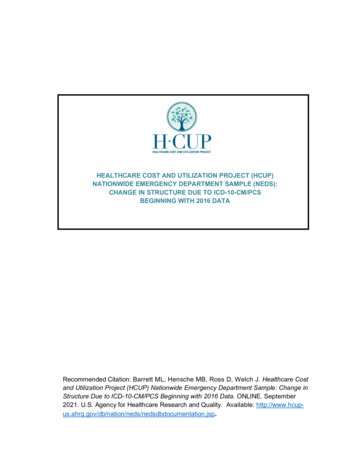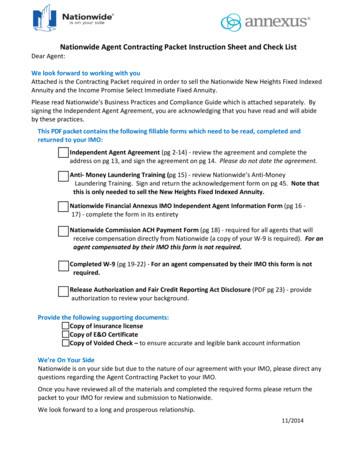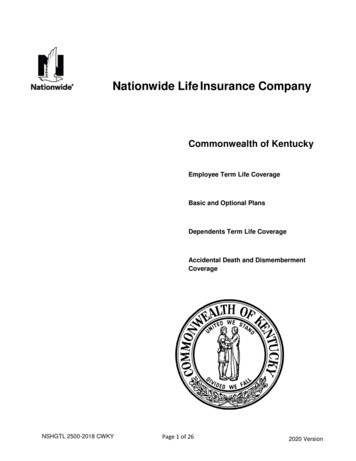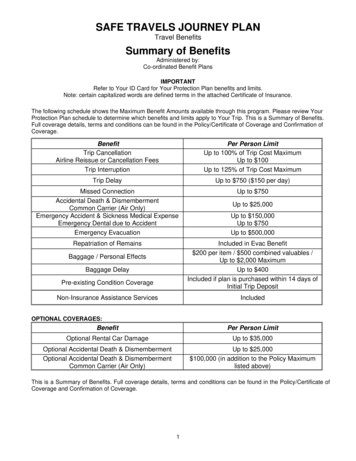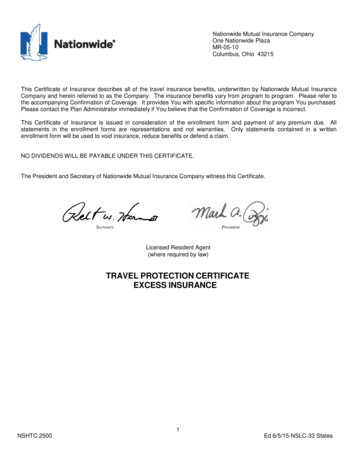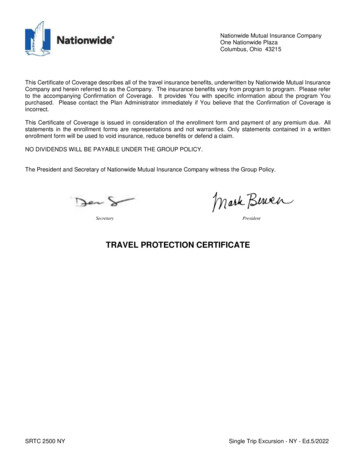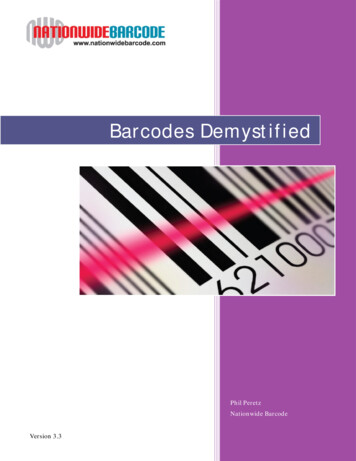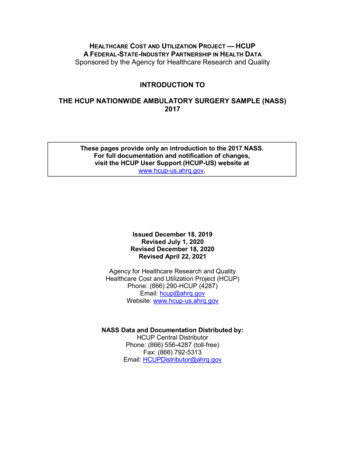
Transcription
HEALTHCARE COST AND UTILIZATION PROJECT — HCUPA FEDERAL-STATE-INDUSTRY PARTNERSHIP IN HEALTH DATASponsored by the Agency for Healthcare Research and QualityINTRODUCTION TOTHE HCUP NATIONWIDE AMBULATORY SURGERY SAMPLE (NASS)2017These pages provide only an introduction to the 2017 NASS.For full documentation and notification of changes,visit the HCUP User Support (HCUP-US) website atwww.hcup-us.ahrq.gov.Issued December 18, 2019Revised July 1, 2020Revised December 18, 2020Revised April 22, 2021Agency for Healthcare Research and QualityHealthcare Cost and Utilization Project (HCUP)Phone: (866) 290-HCUP (4287)Email: hcup@ahrq.govWebsite: www.hcup-us.ahrq.govNASS Data and Documentation Distributed by:HCUP Central DistributorPhone: (866) 556-4287 (toll-free)Fax: (866) 792-5313Email: HCUPDistributor@ahrq.gov
TABLE OF CONTENTSSUMMARY OF DATA USE RESTRICTIONS . 1HCUP CONTACT INFORMATION . 2WHAT IS THE NATIONWIDE AMBULATORY SURGERY SAMPLE (NASS)? . 3UNDERSTANDING THE NATIONWIDE AMBULATORY SURGERY SAMPLE (NASS) . 4ABSTRACT . 5INTRODUCTION TO THE NATIONWIDE AMBULATORY SURGERY SAMPLE (NASS) . 612345OVERVIEW OF NASS DATA. 61.1NASS Data Sources, Hospitals, and Encounters . 61.2Data Restrictions . 81.3File Structure of the NASS. 81.4NASS Data Elements . 8GETTING STARTED . 92.1Decompressing the NASS Files. 92.2Downloading and Running the Load Programs . 102.3NASS Documentation . 102.4HCUP Online Tutorials . 11METHODS . 123.1Creation of the NASS . 123.2Selection of Major Ambulatory Surgeries . 133.3Sampling Design of the NASS . 153.4NASS Sampling Frame. 173.5Sample Weights . 19HOW TO USE THE NASS FOR DATA ANALYSIS . 204.1Calculating National Estimates . 204.2Choosing Data Elements for Analysis . 204.3ICD-10-CM Diagnosis Codes and CPT Procedure Codes . 204.4Missing Values . 214.5Variance Calculations . 214.6Computer Software for Weighted and Variance Calculations . 224.7Limitations of the NASS . 23USER FEEDBACK AND QUESTIONS. 24Appendix A: NASS Introductory Information . A-1Appendix B: 2017 NASS In-Scope Major Ambulatory Surgeries . B-1Appendix C: Data Restrictions .C-1Appendix D: NASS Files and Data Elements .D-1HCUP (4/22/2021)ii2017 NASS Introduction
INDEX OF TABLESTable 1. Number of States, Hospital-Owned Facilities, and Encounters in the NASS by Year . 6Table 2. Independent Variables Included in Encounter Predictive Model . 17Table 3. NASS Stratification Variables . 18Table A.1. HCUP Partner Organizations Participating in the 2017 NASS . A-2Table A.2. NASS-Related Reports and Database Documentation Available on the HCUP-USWebsite . A-4Table A.3. NASS Target Universe, Sampling Frame, and Final Sample Characteristics, 2017 . A-5Table A.4. Percentage of Population in NASS Sample, by Census Region, 2017. A-6Table A.5. Percentage of Encounters and Facilities in NASS Sample, by Census Region, 2017 A7Table B.1. NASS In-Scope Clinical Classifications Software (CCS) for Services and ProcedureCategories . B-2Table B.2. NASS In-Scope Clinical Classifications Software (CCS) for Services and ProcedureCategories Additions and Deletions, by Data Year . B-4Table C.1. Data Restrictions . C-2Table D.1. NASS Hospital File Data Elements, 2017 . D-2Table D.2. NASS Encounter File Data Elements, 2017. D-3Table D.3. NASS Supplemental File Data Elements, 2017 . D-4INDEX OF FIGURESFigure 1. NASS Hospital Universe, SASD Sample, and NASS Sampling Frame . 13Figure 2. Ambulatory Surgeries, Major Ambulatory Surgeries, and In-Scope Major AmbulatorySurgeries . 15Figure A.1. HCUP States and the District of Columbia Included in the 2017 NASS . A-3HCUP (4/22/2021)iii2017 NASS Introduction
HCUP NATIONWIDE AMBULATORY SURGERY SAMPLE (NASS)SUMMARY OF DATA USE RESTRICTIONS***** REMINDER *****All users of the NASS must take the online HCUP Data Use Agreement (DUA) trainingcourse, and read and sign a Data Use Agreement.aAuthorized users of HCUP data agree to the following restrictions:b Will not use the data for any purpose other than research, analysis, and aggregatestatistical reporting. Will not re-release any data to unauthorized users. Will not redistribute HCUP data by posting on any website or publishing in any otherpublicly accessible online repository. Will cite restrictions on data sharing in the DataUse Agreement and direct them to AHRQ HCUP (www.hcup-us.ahrq.gov) for moreinformation on accessing HCUP data if a journal or publication requests access to dataor analytic files. Will not identify or attempt to identify any individual, including by the use of vulnerabilityanalysis or penetration testing. Methods that could be used to identify individualsdirectly or indirectly shall not be disclosed or published. Will not report any statistics where the number of observations (i.e., individualdischarge records) in any given cell of tabulated data is less than or equal to 10 ( 10). Will not publish information that could identify individual establishments (e.g., hospitals)and will not contact establishments. Will not use the data concerning individual establishments for commercial orcompetitive purposes affecting establishments, or to determine rights, benefits, orprivileges of establishments. Will not use the data for criminal and civil litigation, including expert witness testimonyor for law enforcement activities. Will not use data elements from the proprietary severity adjustment software packages(e.g., 3MTM APR-DRGs) for any commercial purpose or to disassemble, decompile, orotherwise reverse engineer the proprietary software. Will acknowledge in reports that data from the "Healthcare Cost and Utilization Project(HCUP)" were used, including names of the specific databases used for analysis.cAny violation of the limitations in the Data Use Agreement is punishable under Federal lawby a fine, up to five years in prison, or both. Violations may also be subject to penaltiesunder State statutes.The online Data Use Agreement training session and the Data Use Agreement are available on theHCUP-US website at www.hcup-us.ahrq.gov.bThis is a summary of key terms of the Data Use Agreement for Nationwide Databases; please referto the DUA for full terms and conditions.c Suggested citations for the HCUP databases are provided in the Requirements for Publishing withHCUP Data available at www.hcup-us.ahrq.gov/db/publishing.jsp.aHCUP (4/22/2021)12017 NASS Introduction
HCUP CONTACT INFORMATIONAll Healthcare Cost and Utilization Project (HCUP) data users, including data purchasersand collaborators, must complete the online HCUP Data Use Agreement (DUA) TrainingCourse and read and sign the HCUP DUA. Proof of training completion and signed DUAsmust be submitted to the HCUP Central Distributor as described below.The online DUA Training Course is available at www.hcup-us.ahrq.gov/tech assist/dua.jsp.The HCUP Nationwide DUA is available on the Agency for Healthcare Research and Qualitysponsored HCUP User Support (HCUP-US) website at www.hcup-us.ahrq.gov.HCUP Central DistributorData purchasers will be required to provide their DUA training completion code and will executetheir DUAs electronically as a part of the online ordering process. The DUAs and trainingcertificates for collaborators and others with access to HCUP data should be submitted directlyto the HCUP Central Distributor using the contact information below.The HCUP Central Distributor also can help with questions concerning HCUP databasepurchases, current orders, training certificate codes, or invoices, if the specific questions are notcovered in the Purchasing Frequently Asked Questions (FAQs) on the Online HCUP CentralDistributor website.Purchasing FAQs: ntly-AskedQuestions.aspxPhone: (866) 556-HCUP (4287) (toll free in the United States)Email: HCUPDistributor@AHRQ.govFax: (866) 792-5313 (toll free)Mailing address:HCUP Central DistributorSocial & Scientific Systems, Inc.8757 Georgia Ave, 12th FloorSilver Spring, MD 20910HCUP User SupportInformation about the content of the HCUP databases and Requirements for Publishing withHCUP Data is available on the HCUP-US website (www.hcup-us.ahrq.gov). For questionsabout using the HCUP databases, software tools, supplemental files, and other HCUP products,or about data use restrictions and publishing with the data, please review the HCUP FAQs orcontact HCUP User Support:HCUP FAQs: www.hcup-us.ahrq.gov/tech assist/faq.jspPhone: (866) 290-HCUP (4287) (toll free)Email: hcup@ahrq.govHCUP (4/22/2021)22017 NASS Introduction
WHAT IS THE NATIONWIDE AMBULATORY SURGERY SAMPLE (NASS)? The Nationwide Ambulatory Surgery Sample (NASS) is a calendar-year, encounterlevel database constructed from the Healthcare Cost and Utilization Project (HCUP)State Ambulatory Surgery and Services Databases (SASD). The NASS is the largest all-payer ambulatory surgery database that has beenconstructed in the United States, yielding national estimates of major ambulatorysurgery encounters performed in hospital-owned facilities. The NASS contains clinicaland resource-use information that is included in a typical hospital-owned facilityrecord, including patient characteristics, clinical diagnostic and surgical procedurecodes, disposition of patients, total charges, expected source of payment, and facilitycharacteristics. Major ambulatory surgeries are identified through Healthcare Common ProcedureCoding System (HCPCS) Level I codes, also known as Current ProceduralTerminology (CPT ) codes. In what follows, HCPCS Level I codes will be called CPTcodes for brevity. These major ambulatory surgeries are selected invasive therapeuticsurgical procedures that typically require the use of an operating room and regionalanesthesia, general anesthesia, or sedation. Procedures intended primarily fordiagnostic purposes were excluded. In addition, other selection criteria were appliedto major ambulatory surgeries included in the NASS and are described below. A total of 33 HCUP Partner organizations contributed to the 2017 NASS: California,Colorado, Connecticut, District of Columbia, Florida, Georgia, Illinois, Indiana, Iowa,Kansas, Kentucky, Maine, Maryland, Michigan, Minnesota, Missouri, Nebraska,Nevada, New Jersey, New York, North Carolina, North Dakota, Ohio, Oklahoma,Oregon, Pennsylvania, South Carolina, South Dakota, Tennessee, Texas, Utah,Vermont, and Wisconsin. These States are geographically dispersed and account for82 percent of the total U.S. resident population, an estimated 63 percent sample of theuniverse of hospital-owned facilities, and an estimated 72 percent sample of theuniverse of ambulatory surgery encounters. Unweighted, the NASS contains approximately 7.6 million major ambulatory surgeryencounters in 2017, corresponding to approximately 9.9 million major ambulatorysurgeries (some encounters have more than one major ambulatory surgery).Weighted, it estimates approximately 10.6 million major ambulatory surgeryencounters and 13.7 million major ambulatory surgeries in the United States. The NASS is a publicly available database that can be purchased through the HCUPCentral Distributor. Currently, the NASS is available for data years 2016 and 2017. Users must complete the HCUP Data Use Agreement Training Course beforereceiving the data.HCUP (4/22/2021)32017 NASS Introduction
UNDERSTANDING THE NATIONWIDE AMBULATORY SURGERY SAMPLE (NASS) This document, Introduction to the HCUP Nationwide Ambulatory Surgery Sample (NASS)2017, summarizes the content of the NASS and describes the development of the NASSsample and weights. Important considerations for data analysis are highlighted, and references to furtherresources are provided. Because the in-scope selection criteria for the NASS are applied each year using the mostrecent data available and the current HCUP Surgery Flag Software for Services andProcedures, CCS procedure groups may be added to and dropped from the NASS samplefrom year to year. For example, CCS 14, Glaucoma procedures was added as an in-scopeCCS category beginning in 2018.Periodically, the list of included Clinical Classifications Software for Services and Procedures(CCS-Services and Procedures) procedure groups in the NASS sample may need to berefined, based on additional information about coding or data collection. For example,Percutaneous Transluminal Coronary Angioplasty (PTCA) CCS 45 was removed from theNASS beginning in 2018. This change was implemented after additional analyses revealedthat these procedures were underreported because of the inability to obtain Level II HCPCScodes from some sample hospitals.In-depth documentation for the NASS is available on the HCUP User Support (HCUP-US)website (www.hcup-us.ahrq.gov). Prior to data year 2019, the NASS sample was limited to SASD encounters that involvedsurgeries defined as “narrow” by the HCUP Surgery Flag Software for Services andProcedures. Subsequent analyses revealed additional encounters involving “narrow” ormajor surgeries that were started in the emergency department and appeared in the StateEmergency Department Databases (SEDD) but not in the SASD. As a result, thesesurgeries are undercounted in the 2016–2018 NASS. The procedures most impacted bythis issue include appendectomy and removal of ectopic pregnancy (each undercounted bymore than 50%) and cholecystectomy (undercounted by approximately 10%). In subsequentdata years, these emergent in-scope surgeries are captured in the NASS.HCUP (4/22/2021)42017 NASS Introduction
HEALTHCARE COST AND UTILIZATION PROJECT—HCUPA FEDERAL-STATE-INDUSTRY PARTNERSHIP IN HEALTH DATASponsored by the Agency for Healthcare Research and QualityHCUP Nationwide Ambulatory Surgery Sample (NASS)ABSTRACTThe Nationwide Ambulatory Surgery Sample (NASS) is part of the Healthcare Cost andUtilization Project (HCUP), which is sponsored by the Agency for Healthcare Research andQuality (AHRQ).The NASS was created to enable analyses of selected ambulatory surgery utilization patternsand to support public health professionals, administrators, policymakers, and clinicians in theirdecision making regarding this critical source of care. The NASS contains clinical and resourceuse information that is included in a typical hospital-owned facility record abstract, includingpatient characteristics, clinical diagnostic and surgical procedure codes, disposition of patients,total charges, expected source of payment, and facility characteristics. Therefore, it enablesgovernment entities, industry professionals, and researchers to develop research concepts withdata-driven applications.The NASS is the largest all-payer ambulatory surgery database that has been constructed in theUnited States, yielding national estimates of major ambulatory surgery encounters performed inhospital-owned facilities. It contains information from 7.6 million ambulatory surgery encountersat 2,737 hospital-owned facilities that approximate an estimated 63 percent stratified sample ofU.S. hospital-owned facilities performing ambulatory surgeries. Weights are provided tocalculate national estimates totaling 10.6 million ambulatory surgery encounters in 2017.The NASS is drawn from statewide data organizations that provide HCUP with data fromambulatory surgery encounters. Thirty-three HCUP Partner organizations participated in the2017 NASS. See Appendix A, Table A.1 for a list of HCUP Partner organizations thatcontributed to the 2017 NASS.By stratifying on important facility characteristics, the NASS is designed to be representative ofU.S. hospital-owned facilities that perform ambulatory surgeries. Stratification is based on thefollowing characteristics: Geographic region (Northeast, Midwest, South, and West)Hospital bed size (small, medium, and large dependent on region, location, and teachingstatus)Urban-rural location of the hospital (metropolitan and nonmetropolitan)Hospital teaching statusHospital ownership or control (public, for profit, and not for profit)Access to the NASS is open to users who sign Data Use Agreements. Uses are limited toresearch and aggregate statistical reporting.For more information on the NASS, visit the AHRQ-sponsored HCUP User Support (HCUP-US)website at ation.jsp.HCUP (4/22/2021)52017 NASS Introduction
INTRODUCTION TO THE NATIONWIDE AMBULATORY SURGERY SAMPLE (NASS)1OVERVIEW OF NASS DATAThe Healthcare Cost and Utilization Project (HCUP) Nationwide Ambulatory Surgery Sample(NASS) was created to enable analysis of selected ambulatory surgery utilization patterns andto support public health professionals, administrators, policymakers, and clinicians in theirdecision making regarding this critical source of care. The NASS has many research, policy,and other data-driven applications because it contains clinical and nonclinical information aboutmajor ambulatory surgeries and diagnoses as well as geographic, facility, and patientcharacteristics.1.1NASS Data Sources, Hospitals, and EncountersThe NASS is sampled from the HCUP State Ambulatory Surgery and Services Databases(SASD), which include various types of outpatient services, such as observation stays,lithotripsy, radiation therapy, imaging, chemotherapy, and labor and delivery. The specific typesof ambulatory surgeries and outpatient services included in each SASD vary by State and datayear. All SASD include data on ambulatory surgery encounters from hospital-owned facilities.Some States include data from nonhospital-owned facilities, although these are not included inthe NASS. 1 The SASD do not include ambulatory surgery encounters that were subsequentlyadmitted to the same hospital for inpatient care. As such, the NASS does not contain anyencounters admitted from the ambulatory setting to the inpatient setting. Information on patientsadmitted to the hospital following ambulatory surgery is included in the HCUP State InpatientDatabases (SID).The number of States, hospital-owned facilities, and ambulatory surgery encounters in theNASS varies by year (Table 1).Table 1. Number of States, Hospital-Owned Facilities, and Encounters in the NASSby YearNumber of ASNumber ofNumber of ASEncounters,DataHospitalEncounters,States in the NASSWeighted A, CO, CT, DC, FL, GA, IA, IL, IN,KS, KY, MD, ME, MI, MN, MO, NC,ND, NE, NJ, NV, NY, OH, OK, OR,20172,7377,647,63610,570,649PA, SC, SD, TN, TX, UT, VT, WI(HI data were not available)CA, CO, CT, DC, FL, GA, HI, IA, IL,IN, KS, KY, MD, ME, MI, MN, MO,20162,7517,608,87910,623,113NC, ND, NE, NJ, NV, NY, OH, OK,OR, PA, SC, SD, TN, TX, UT, VT, WIThe following States have at least one freestanding facility in the HCUP SASD: California, Florida,Illinois, Kentucky, Michigan, Missouri, North Carolina, Nevada, New York, Oklahoma, Oregon,Pennsylvania, South Carolina, Utah, and Wisconsin.1HCUP (4/22/2021)62017 NASS Introduction
Abbreviations: AS, Ambulatory Surgery; NASS, Nationwide Ambulatory Surgery Sample; SASD, StateAmbulatory Surgery and Services Databases.The 2017 NASS sample comprises data from 33 HCUP Partner organizations (32 States andthe District of Columbia). Appendix A, Figure A.1 represents the geographic distribution of theHCUP Partner organizations that contributed to the 2017 NASS. The HCUP NASS States withthe District of Columbia account for 82 percent of the U.S. population in 2017, an estimated 63percent of hospital-owned facilities performing ambulatory surgeries, and an estimated 72percent of ambulatory surgery encounters. Details on the percentage of population, encounters,and facilities by region are provided in Appendix A, Table A.4 and Appendix A, Table A.5.The NASS is limited to encounters with at least one in-scope major ambulatory surgery on therecord, performed at hospital-owned facilities. In-scope major ambulatory surgeries are definedas selected invasive, therapeutic surgical Current Procedural Terminology (CPT)-codedprocedures that typically require the use of an operating room and regional anesthesia, generalanesthesia, or sedation. These surgeries are flagged as narrow in the HCUP Surgery FlagSoftware. 2 They also belong to a subset of Clinical Classifications Software (CCS) 3 proceduregroups with a relatively high major ambulatory surgery volume, a substantial share of majorambulatory surgeries performed in hospital-owned facilities, and evidence of reliable reportingfrom SASD hospitals. Detailed major ambulatory surgery selection criteria are outlined inSection 3.2. A complete list of 2017 in-scope CCS procedure groups is included in Appendix B.The 2017 sample includes 2,737 hospitals, 7,647,636 in-scope major ambulatory surgeryencounters (unweighted), and 10,570,649 in-scope major ambulatory surgery encounters(weighted for national estimates).Prior to data year 2019, the NASS sample was limited to SASD encounters that involvedsurgeries defined as “narrow” by the HCUP Surgery Flag Software for Services and Procedures.Subsequent analyses revealed additional encounters involving “narrow” or major surgeries thatwere started in the emergency department and appeared in the State Emergency DepartmentDatabases (SEDD) but not in the SASD. As a result, these surgeries are undercounted in the2016–2018 NASS. The procedures most impacted by this issue include appendectomy andremoval of ectopic pregnancy (each undercounted by more than 50%) and cholecystectomy(undercounted by approximately 10%). In subsequent data years, these emergent in-scopesurgeries are captured in the NASS.Although encounters are limited to those with at least one in-scope major ambulatory surgery onthe record, the NASS Supplemental File provides information on other surgical and nonsurgicalprocedures performed during these encounters (see Section 1.3).Agency for Healthcare Research and Quality. Surgery Flag Software for Services and Procedures.Healthcare Cost and Utilization Project (HCUP). Last modified August 7, 2019. www.hcupus.ahrq.gov/toolssoftware/surgeryflags svcproc/surgeryflagssvc proc.jsp. Accessed June 30, 2020. Theterms narrow and broad are specific to the Surgery Flag Software. The 2017 NASS applied a preliminaryversion of v2019.2 that included narrow surgeries identified in the following ranges of CPT codes: surgical(10004-69990), emerging technology (0100T-0588T), and cardiac-related medical (92920-93986).3 The Clinical Classifications Software for Services and Procedures (CCS-Services and Procedures) isHCUP software that provides a method for classifying CPT codes and Healthcare Common ProcedureCoding System (HCPCS) codes into clinically meaningful procedure categories. More than 9,000CPT/HCPCS codes and 6,000 HCPCS codes are collapsed into 244 clinically meaningful categories thatmay be more useful for presenting descriptive statistics than are individual CPT or HCPCS codes. Formore information, visit www.hcup-us.ahrq.gov/toolssoftware/ccs svcsproc/ccssvcproc.jsp.2HCUP (4/22/2021)72017 NASS Introduction
1.2Data RestrictionsSome HCUP Partner organizations that contributed data to the NASS imposed restrictions onthe release of certain data elements. In addition, because of confidentiality laws, some datasources were prohibited from providing HCUP with encounter records that indicated specificmedical conditions, such as HIV/AIDS or behavioral health conditions. Detailed information onthese restrictions is available in Appendix C.1.3File Structure of the NASSThe NASS is delivered as a set of related tables. A hospital table lists hospitals in the NASSalong with hospital attributes (e.g., teaching status, bed size category) as well as the encounterweight and sample stratum information. An encounter table links to the hospital table andcontains information on the major ambulatory surgery encounter (e.g., patient age, expectedsource of payment, diagnoses), including information about in-scope major ambulatorysurgeries. A related supplemental table contains entries for out-of-scope procedures with a keylinking to the encounter table.Hospital File: This hospital-level file contains one observation for each hospital included in theNASS, along with encounter weight and stratum data elements. For 2017, the NASS HospitalFile has 2,737 hospital-specific records. A list of data elements in the Hospital File is providedin Appendix D, Table D.1.Encounter File: This encounter-level file contains 100 percent of ambulatory surgeryencounters containing a major ambulatory surgery from the sample of hospitals in participatingStates and the District of Columbia. For 2017, the NASS Encounter File has about 7.6 millionambulatory surgery encounter records (unweighted). Refer to Appendix D, Table D.2 for a listof data elements in the NASS Encounter File.Supplemental File: This encounter-level file contains information on procedures that wereperformed during encounters recorded in the Encounter File but not considered to be in-scopemajor ambulatory surgeries in the NASS. The Supplemental File contains about 5.2 millionrecords for 2017. Procedures included on the Supplemental File are limited to HealthcareCommon Procedure Coding System (HCPCS) Level I (CPT) procedure codes. HCPCS Level IIcodes were excluded from the Supplemental File. Refer to Appendix D, Table D.3 for a list ofdata elements in the NASS Supplemental File.1.4NASS Data ElementsThe coding of data elements in the NASS is consistent with the coding in other HCUPdatabases. The following three objectives guided the definition of data elements in all HCUPdatabases: Ensure usability without extensive editing by analysts Retain the largest amount of information available from the original sources, while stillmaintaining consistency among sources Structure the information for efficient storage, manipulation, and analysisMore information on the coding of HCUP data elements is available on the HCUP User Support(HCUP-US) website (www.hcup-us.ahrq.gov/db/coding.jsp).After analyzing the availability of information from the HCUP Partner organizations, a set ofcommon fields to be available in the NASS was created. The NASS contains more than 100clinical and nonclinical variables, such as the following:HCUP (4/22/2021)82017 NASS Introduction
Patient demographics (e.g., sex, age, urban-rural designation of residence, nationalquartile of the median household annual income for the patient’s ZIP Code) HCPCS Level I, also known as Current Procedure Terminology (CPT) procedure codes International Classification of Diseases, T
anesthesia, general anesthesia, or sedation. Procedures intended primarily for diagnostic purposes were excluded. In addition, other selection criteria were applied to major ambulatory surgeries included in the NASS and are described below. A total of 33 HCUP Partner organizations contributed to the 2017 NASS: California,


